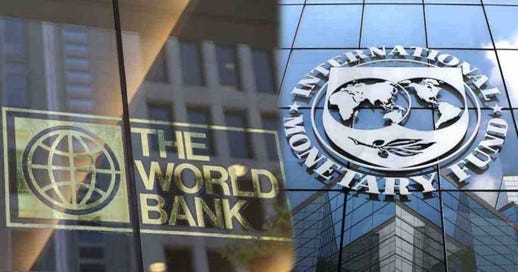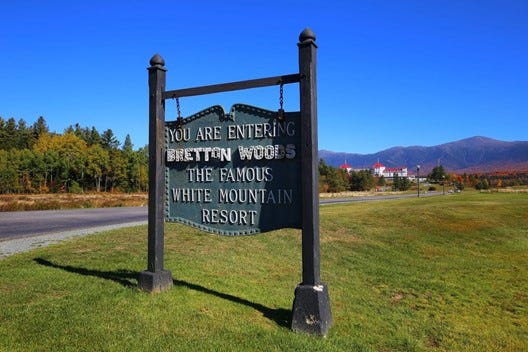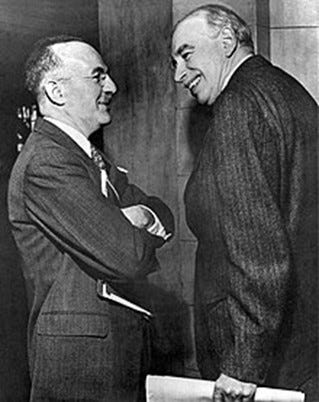It is a commonplace assumption, supported by evidence, that people tend to become more conservative as they grow older. So far, at 51, I seem to be bucking that trend and going in the opposite direction, but there is still time I suppose.
It is definitely the case for those two elderly institutions, the World Bank and the IMF, both of which turned 80 this year. During their youth, they leaned more to the left, but when they hit forty, they clearly had a midlife reckoning and lurched rightwards. They have stayed there pretty much ever since. The story of their birth and their relatively radical youthful years is not well known.
The IMF and the World Bank were designed and agreed over three hot weeks at the secluded Mount Washington Hotel in Bretton Woods, New Hampshire, during the summer of 1944. The Second World War was raging. London was being bombed by German V2 missiles. The Red Army was marching toward Germany and the Allies had only landed on the Normandy beaches the month before. Many of the delegates attending the conference had sons who were fighting. The Greek delegate had just escaped a Nazi prisoner of war camp.
How the IMF was possibly designed by a Soviet Spy
The conference was driven by two key figures: the tall, brilliant, posh and pompous economist John Maynard Keynes from Britain and Harry Dexter White, a small, sharp and much less posh but equally pompous economist from the US treasury. The two regularly clashed fiercely.
Whereas Keynes remains famous to this day, White is not. This is partly because a few years after the conference he was accused of being a Soviet spy and he died shortly after appearing in front of the House Un-American Activities Committee.
The evidence that he was a spy is now generally thought to be inconclusive. But it is clear that he was sympathetic to the Soviets. At that time, this was not an uncommon view, not least because the Soviets were paying a huge price to bravely fight off Hitler. The rabid anti-communism of the Cold War was still years in the future.
This admiration was also economic. Whilst the economies of the capitalist world had been devastated by the Great Depression, the communist economy of the Soviet Union was seemingly immune and growing and industrialising rapidly.
Overall, the United States dominated the proceedings. White was a tireless and brilliant negotiator and played a huge part in the successful outcome. The war had led to the bankruptcy and collapse of the economies of Europe and Asia, yet conversely restored strong growth to the US. The US represented nearly 40% of the global economy and was the main creditor, with many of the other allied nations being heavily in their debt. This meant that what the US wanted it broadly got. It also meant they led the design of the IMF, which was the much more important negotiation because it was to create the rules for the whole global economy. Keynes instead led on designing the World Bank, which was a bit of an afterthought.
Despite the US being the boss there was nevertheless much consensus both between Keynes and White, and between them and the other delegates from 44 countries. They had all lived through the terrible economic decades after WW1. They had seen how a failing global monetary system had helped fuel the rise of extremism. They had seen how unregulated banks and finance had destroyed their economies, leaving tens of millions unemployed and hungry which added further fuel to the fascist fire.
They had also seen how state involvement in large sections of their economy was possible and indeed preferable. In the US through the New Deal, and then in the UK and other countries in response to the war economy needs of WW2, it was clear that the state had a clear role to play in shaping and planning the economy. This was also at the heart of Keynes’ economic thought, in contrast to the laissez-faire, market-first approach that had dominated in the past.
One very strong area of agreement was the need to control the flow of capital and the power of financial markets. They all agreed that the Great Depression was driven by the failure to do exactly this, to control Wall Street.
Bankers were definitely not invited to help design the IMF or the World Bank
As a result, not one banker from Wall Street or London was invited to this conference that was to set the rules that would govern global finance for decades to come. This would be absolutely unthinkable today. Think of the financial crisis of 2007-8, when Wall Street bankers, who had once again crashed the global economy and taken it to the edge of chaos, were actually invited to help design their own bailout, by a Treasury Secretary recruited directly from Goldman Sachs.

The agreements reached in Bretton Woods, to limit the flows of capital around the world and link all currencies to the dollar over the next few decades, underpinned a period of economic stability and growth in the global economy unrivalled before or since.
However, this consensus – that markets and global finance needed to be controlled and put at the service of the wider economy and society – was dropped in the late 1970s with the rise of neoliberal economic thought. The World Bank and the IMF then became the standard bearers of a new “Washington Consensus,” which is the story we are all a lot more familiar with.
They were driven not only by a change in the politics in the US, but also in a shift in economic thinking generally, as mainstream economics moved to its current state of wilful myopia.
How would White and Keynes feel if they were suddenly brought back to life today? There is certainly lots in the modern world they would recognise with horror. The huge power of financial markets to dictate terms to governments, for one. Great power rivalry spilling over into attempts to manage the world in a more rational way. War and conflict dominating and spreading.
How would they feel about their offspring, the World Bank and the IMF? Would they be shocked to see how they have come to press for the kinds of policies they were originally set up to prevent? In the UK our mercifully short-lived right-wing Prime Minister, Liz Truss, who modelled herself on Mrs. Thatcher, has parents who are strongly on the left. Perhaps they would feel as appalled as White and Keynes surely would be.
Keynes and White would probably agree heartily with the recent shift away from neoliberalism, but be horrified with what is being constructed in its place. Instead of the “Washington Consensus,” we now have the “Wall Street Consensus.” In the last 15 years, first during the financial crisis and then during the pandemic, trillions of dollars were pumped into the economy by governments. This led to a huge inflation in assets and wealth in private hands, and a corresponding leap in inequality. It has given even greater power to the financial markets and the banks.
This is exactly the time when we should be ensuring this public money is clawed back out of private hands and put to public use and the financial sector once again made the servant of the real economy. Instead the prevailing view is that even more public money should be used to bribe and cajole rich investors with their private trillions into doing the right thing for the world. I think Keynes and White would have seen this for the rather obvious confidence trick that it seems to me it clearly is.
Author: Max Lawson, Head of Inequality Policy at Oxfam International and EQUALS podcast co-host. He is also the co-chair of the Global People’s Medicines Alliance.
This week on EQUALS podcast, Grazielle and Nafkote delve deep into the movement with Grace Wendo, a passionate youth activist and student leader from Kenya. Tune in to uncover the power of the people, the role of the IMF, and the historic events that shook a nation.
Always remember to share and follow us on X and on LinkedIn.







I learned so much from this!
Thank you for a thorough and enlightening read.